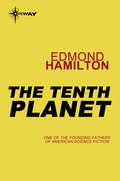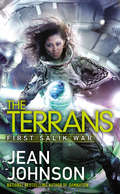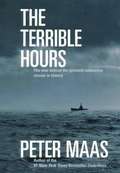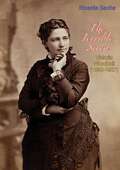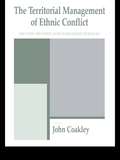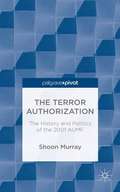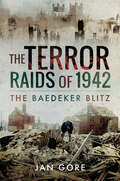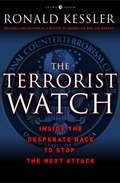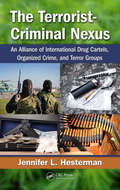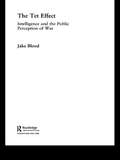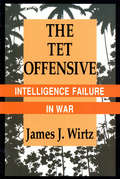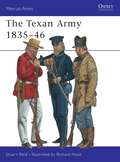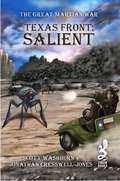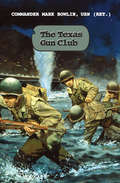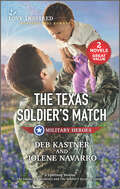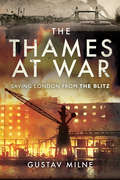- Table View
- List View
The Tenth Planet
by Edmond HamiltonCaptain Future meets Captain Future...The two men stood facing each other.One man was tall and impressive. His red hair, his self-assured manner, the global ring he wore on his finger, left no question in the minds of viewers that he was the man he said he was - the man known the Solar System over as Captain Future.The other man was tall too, but fierce looking, with a wild black beard and a scarred face. They called him Blackbeard and believed he was a space pirate, although the main claimed he didn't remember who he was. Not even he suspected that he might be the real Captain Future...
The Terrans
by Jean JohnsonJean Johnson's first novel in an explosive new science fiction trilogy set in the world of the national bestselling Theirs Not to Reason Why series--set two-hundred years earlier, at the dawn of the First Salik War...Born into a political family and gifted with psychic abilities, Jacaranda MacKenzie has served as a border-watcher and even spent time as a representative on the United Planets Council. Now she just wants to spend her days in peace and quiet as a translator--but the universe has other plans...Humans have long known that they would encounter more alien species, and while those with precognitive abilities agree a terrible war is coming, they do not agree on who will save humanity--a psychic soldier or a politician.But Jackie is both.After she is pressured into rejoining the Space Force to forestall the impending calamity, Jackie makes an unsettling discovery. Their new enemy, the Salik, seem to be rather familiar with fighting Humans--as if their war against humanity had already begun...
The Terrible Hours
by Peter MaasOn the eve of World War II, the Squalus, America's newest submarine, plunged into the North Atlantic. Miraculously, thirty-three crew members still survived. While their loved ones waited in unbearable tension on shore, their ultimate fate would depend upon one man, U.S. Navy officer Charles "Swede" Momsen-an extraordinary combination of visionary, scientist, and man of action. In this thrilling true narrative, prize-winning author Peter Maas brings us in vivid detail a moment-by-moment account of the disaster and the man at its center. Could he actually pluck those men from a watery grave? Or had all his pioneering work been in vain?
The Terrible Siren: Victoria Woodhull (1838-1927)
by Emanie SachsAs Publishers Weekly noted, “No heroine of any romance ever had a more adventurous career than this unvictorian Victoria.”In Victoria Woodhull’s prime during the mid to late 1800s, women were not allowed to vote, were not encouraged to run a business, and certainly did not speak of free love, much less get divorced. Women endured other ridiculous conventions, like not being seen outside a home after dark without an escort. Restaurants refused to serve single women after 6pm.Victoria Woodhull smashed all these conventions and many more. She married for the first time while only 15 years old. She was married at least 3 times, with 2 divorces.Victoria held seances for Cornelius Vanderbilt to give him tips. With his mentorship, she, along with Tennessee, her equally beautiful sister, opened their own stock brokerage firm and were the first female brokers on Wall Street. One reviewer said it was a time “when a woman in business was as great a novelty as an elephant in a balloon.”The sisters ran a weekly newspaper in New York that ardently advocated for free love. Anthony Comstock sent them to jail for the contents of that paper.Victoria was a skillful orator who pushed for women’s equality, especially suffrage. One reviewer stated, “Audiences came to denounce her and stayed to acclaim her.”She was the first woman to be nominated for President of the United States by a political party. She ran in 3 different elections.She was the first woman to receive an official hearing before a congressional committee, when she presented a memorial about woman suffrage.Victoria unapologetically sought the spotlight and practiced what she preached despite notoriety and persecution.
The Territorial Air Force: The RAF's Voluntary Squadrons, 1926–1957
by Frances Louise Wilkinson“What is almost certainly the definitive account of the Auxiliary Air Force, the Special Reserve and the Royal Air Force Volunteer Reserve.” —Paul Nixon, Army Ancestry ResearchTo date, little has been written about the Territorial Air Force as a voluntary military organization and no sustained analysis of its recruitment and social composition undertaken. Made up of three different parts, the Auxiliary Air Force, the Special Reserve and the Royal Air Force Volunteer Reserve, these three separate and different groups have not featured significantly in existing literature.Along with a history of the Territorial Air Force, this book includes an analysis of how the volunteers joined, and what kinds of men were accepted into the organizations as both pilots and officers. The influences class and social status had on recruitment in the run up to the Second World War are also discussed. There is an exploration of the key differences between the Auxiliary squadrons and the SR squadrons, as well as the main reasons for the idea of merging the SR squadrons into the AAF squadrons. Briefly discussed are the newly formed University Air Squadrons that were set up to promote “air mindedness” and to stimulate an interest and research on matters aeronautical. Military voluntarism continued to play a key role in the defense of twentieth-century Britain, and class ceased to be the key determining factor in the recruitment of officers as the organizations faced new challenges. Within both the AAF and the RAFVR the pre-war impression of a gentlemen’s flying club finally gave way to a more meritocratic culture in the post-war world.
The Territorial Management of Ethnic Conflict (Routledge Studies in Federalism and Decentralization #Vol. 9)
by John CoakleyThe object of this book is to look at the manner in which states attempt to cope with ethnic conflict through territorial approaches. This revised edition has new chapters covering Northern Ireland, South Africa and Yugoslavia.
The Territorials, 1908–1914: A Guide for Military and Family Historians
by Ray WestlakeThe Territorials 1908–1914 is a unique, comprehensive record of the part-time soldiers who made up the Territorial Force that supported the regular army in the years immediately before the outbreak of the First World War. Previously information on the history and organization of these dedicated amateur soldiers has been incomplete and scattered across many sources but now, in this invaluable work of reference, Ray Westlake provides an accessible introduction to the Territorial Force and a directory of the units raised in each county and each town. The origin, aims and organization of the Territorial Force are described as well as the terms of service, recruitment, equipment and training. But the bulk of the book consists of details of over 600 Territorial units plus a comprehensive account of every city, town or village associated with them. Essential information on the all the infantry formations is supplied, but also covered are the yeomanry, the artillery, the engineers, the Royal Army Medical Corps and the Army Service Corps. Ray Westlakes historical guide of the Territorial Force the forerunner of the present-day Territorial Army - will be of enduring value to military and family historians.
The Terror Authorization: The History and Politics of the 2001 AUMF
by Shoon MurrayThree days after September 11, 2001, Congress passed an unprecedented authorization of the use of military force (AUMF 2001) that remains in force today. As the theatre of operation against terrorism changes, the applicability and legality of the AUMF 2001 is under increasing scrutiny - giving way to academic discussion over its current status.
The Terror Raids of 1942: The Baedeker Blitz
by Jan GoreMeticulous research provides the fullest insight yet into the impact of this bombing campaign on Britain’s home front during the Second World War.“We shall go out and bomb every building in Britain marked with three stars in the Baedeker Guide,” the German Foreign Office announced in April 1942 as the Luftwaffe attacked Exeter, Bath, Norwich, York and Canterbury. Over a thousand people died. These raids were direct retaliation for RAF raids on equally historic German cities. Hitler had ordered that “Preference is to be given . . . where attacks are likely to have the greatest possible effect on civilian life,” and in this narrow aim—as Jan Gore shows in the first full history of the raids to be published for over twenty years—they certainly succeeded.She explains the Luftwaffe’s tactics, the types of bombs that were used—high explosive, parachute mines and incendiaries—and records the devastating damage they caused. Her main focus is on the effect of the bombing on the ground. In graphic detail she describes the air raid precautions, the role of the various civil defense organizations and the direct experience of the civilians. Their recollections—many of which have not been published before—as well as newspaper articles and official reports give us a vivid impression of the raids themselves and their immediate aftermath.“One can never understand what either side hoped to achieve by destroying historic cities and killing and maiming their citizens during a conflict such as the second world war. Jan Gore attempts to explain the thinking behind it, and the awful consequences . . . A terrific account.” —Books Monthly
The Terror Raids of 1942: The Baedeker Blitz
by Jan GoreMeticulous research provides the fullest insight yet into the impact of this bombing campaign on Britain’s home front during the Second World War.“We shall go out and bomb every building in Britain marked with three stars in the Baedeker Guide,” the German Foreign Office announced in April 1942 as the Luftwaffe attacked Exeter, Bath, Norwich, York and Canterbury. Over a thousand people died. These raids were direct retaliation for RAF raids on equally historic German cities. Hitler had ordered that “Preference is to be given . . . where attacks are likely to have the greatest possible effect on civilian life,” and in this narrow aim—as Jan Gore shows in the first full history of the raids to be published for over twenty years—they certainly succeeded.She explains the Luftwaffe’s tactics, the types of bombs that were used—high explosive, parachute mines and incendiaries—and records the devastating damage they caused. Her main focus is on the effect of the bombing on the ground. In graphic detail she describes the air raid precautions, the role of the various civil defense organizations and the direct experience of the civilians. Their recollections—many of which have not been published before—as well as newspaper articles and official reports give us a vivid impression of the raids themselves and their immediate aftermath.“One can never understand what either side hoped to achieve by destroying historic cities and killing and maiming their citizens during a conflict such as the second world war. Jan Gore attempts to explain the thinking behind it, and the awful consequences . . . A terrific account.” —Books Monthly
The Terrorist Watch: Inside the Desperate Race to Stop the Next Attack
by Ronald KesslerBased almost entirely on sources within the Federal Bureau of Investigation and the Central Intelligence Agency--prominently including FBI Director Mueller, CIA Director Hayden, and White House Counterterrorism Chief Townsend--this work by Kessler (chief Washington correspondent for NewsMax.com), aimed at a general audience, is an entirely one-sided and hagiographic account of US government counterterrorism operations in the wake of the September 11th attacks. Describing the activities of his heroic FBI and CIA agents, Kessler not infrequently descends outright into cynical apologia. To cite but one example, torture is mentioned exactly three times in the book, twice to claim that the CIA never engages in such practices, although it is admitted that they do employ sleep deprivation and stress positions, techniques considered by many reputable experts to be torture, and once to dismiss any concerns about the so-called "extraordinary rendition" program, which often hands American-held detainees over to countries that routinely employ torture for interrogation. "Why should the U.S. give them a safe haven from the laws and practices of their own countries?" asks Kessler. Annotation ©2008 Book News, Inc., Portland, OR (booknews.com)
The Terrorist-Criminal Nexus: An Alliance of International Drug Cartels, Organized Crime, and Terror Groups
by Jennifer L. HestermanPostmodern global terrorist groups engage sovereign nations asymmetrically with prolonged, sustained campaigns driven by ideology. Increasingly, transnational criminal organizations operate with sophistication previously only found in multinational corporations. Unfortunately, both of these entities can now effectively hide and morph, keeping law e
The Terrorists of Iraq: Inside the Strategy and Tactics of the Iraq Insurgency 2003-2014, Second Edition
by Malcolm W. NanceThe Terrorists of Iraq: Inside the Strategy and Tactics of the Iraq Insurgency 2003-2014, Second Edition is a highly detailed and exhaustive history and analysis of terror groups that both formed the Iraq insurgency and led to the rise of the Islamic State of Iraq and Syria (ISIS). It places heavy emphasis on the history, organization, and personal
The Tet Effect: Intelligence and the Public Perception of War (Cass Military Studies)
by Jake BloodA close examination of the role of intelligence in shaping America’s perception of the Vietnam War, looking closely at the intelligence leadership and decision process. In 1967, intelligence was called upon to bolster support for the Vietnam War and allowed America’s leaders to portray a ‘bankrupt’ enemy ready to quit the battlefield. The audacious Tet Offensive of 1968 shattered this image and although it ended with an American military victory, it is remembered as the juncture when American support turned against the war. Public opinion on the war was a primary concern for the Johnson Administration, and US intelligence played a decisive role in providing an overly optimistic view of the enemy’s demise. As the "bankrupt" enemy attacked with a ferocity and intensity that shocked the American public, intelligence had set-up the American public for a fall. How, Americans wanted to know, could an enemy whose numbers had been so decimated now launch such an all-out offensive? From this examination and an understanding of how the enemy viewed itself, the conclusion is made that four severe breaches of intelligence etiquette occurred during the period leading up to Tet. This phenomenon is the ‘Tet effect’ – the loss of credibility when leaders portray a situation based upon intelligence that is shown to be disingenuous. This book will be of great interest to students of the Vietnam war, intelligence and strategic studies in general.
The Tet Offensive: A Brief History with Documents
by William Thomas AllisonWith Americans turning against the war in ever greater numbers, struggles for power between the government and the military, and no end in sight to the fighting, the Tet Offensive of 1968 proved to be the turning point of the Vietnam War. In The Tet Offensive, historian William Thomas Allison provides a clear, concise overview of the major events and issues surrounding the Tet Offensive, and compiles carefully selected primary sources to illustrate the complex military, political, and public decisions that made up Tet. The Tet Offensive is composed of two parts: an accessible, well-illustrated narrative overview, and a collection of core primary source documents. Throughout the narrative, historiographic questions are addressed within the text to highlight discussion among historians over pivotal points of debate. The objectively selected documents provide students with raw material from which to gain insight into these events through their own analysis, and to improve their ability to discuss and understand the importance of historical scholarship. Approachable and insightful, The Tet Offensive is not only a great introduction to reading history through primary sources, it is an essential tool for understanding what made the Tet Offensive such an important turning point of the Vietnam War.
The Tet Offensive: A Concise History
by James WillbanksIn the Tet Offensive of 1968, Viet Cong and North Vietnamese forces launched a massive countrywide attack on South Vietnam. Though the Communists failed to achieve their tactical and operational objectives, James Willbanks claims Hanoi won a strategic victory. The offensive proved that America's progress was grossly overstated and caused many Americans and key presidential advisors to question the wisdom of prolonging combat. Willbanks also maintains that the Communists laid siege to a Marine combat base two weeks prior to the Tet Offensive-known as the Battle of Khe Sanh—to distract the United States. It is his belief that these two events are intimately linked, and in his concise and compelling history, he presents an engaging portrait of the conflicts and singles out key problems of interpretation.Willbanks divides his study into six sections, beginning with a historical overview of the events leading up to the offensive, the attack itself, and the consequent battles of Saigon, Hue, and Khe Sahn. He continues with a critical assessment of the main themes and issues surrounding the offensive, and concludes with excerpts from American and Vietnamese documents, maps and chronologies, an annotated list of resources, and a short encyclopedia of key people, places, and events.An experienced military historian and scholar of the Vietnam War, Willbanks has written a unique critical reference and guide that enlarges the debate surrounding this important turning point in America's longest war.
The Tet Offensive: Intelligence Failure in War (Cornell Studies in Security Affairs)
by James J. WirtzIn this account of one of the worst intelligence failures in Americanhistory, James J. Wirtz explains why U.S. forces were surprised by the North Vietnamese Tet Offensive in 1968. Wirtz reconstructs the turning point of the Vietnam War in unprecedented detail. Drawing upon Vietcong and recently declassified U.S. sources, he is able to trace the strategy and unfolding of the Tet campaign as well as the U.S. response.
The Texan Army 1835-46
by Richard Hook Stuart ReidThe volunteer army that fought the Mexican dictator Santa Anna from 1835 to 1836 was immortalized in the epic battle of the Alamo. Taking arms initially to fight for the restoration of the liberal Mexican constitution of 1824, the volunteers were eventually fighting for outright Texan independence. This book describes and illustrates the group of men who, despite the diversity of their origins, equipment, weaponry and dress, were united in a common cause that reached its culmination in the victory of San Jacinto. The turbulent decade (1836-46) of Texan independence is also covered, and the little-studied army and navy of the Republic of Texas examined.
The Texan Code
by Diana PalmerThese alpha men will do anything to protect the women they love in two Western romantic suspense novels from a New York Times–bestselling author.Mercenary’s WomanAll retired soldier of fortune Ebenezer Scott wants is some peace and quiet. Though when schoolteacher Sally Johnson’s life is put in danger, Eb will do anything to keep her safe. Sally doesn’t want his help—he broke her heart six years ago, and she can’t trust him to not hurt her again. Now Eb must risk it all to win the sweet-natured beauty over . . . before it’s too late.The Winter SoldierMost people in town steer clear of brooding Cy Parks. But gorgeous Lisa Monroe doesn’t exactly quake in her boots at the sight of Cy. Their passion escalates when Cy returns to the line of duty and claims Lisa as his wife to shield her from a revenge-seeking enemy. But who will protect the beguiling bride from him?
The Texas Front: Salient (The Great Martian War #4)
by Scott Washburn Jonathan Cresswell-JonesThe Martian invaders have overrun the American heartland. Between the Mississippi and the Rockies, only Texas holds out, written off by the high command in Washington, and with revolution brewing in Mexico. Texas has become the Martians' new target. Across the Lone Star State, soldiers, Rangers, and civilians alike prepare to repel the next attack, outmatched and outgunned – yet undaunted. Governor Colquitt and General Funston plan to build their own weapons, raise their own armies, and perhaps take the war into their own hands. But the Martians may not be their only concern...
The Texas Gun Club (The Texas Gun Club #1)
by Commander Mark BowlinTwo very different cousins head to Italy to fight in World War II in this absorbing novel, a winner of the Military Writers Society of America Gold Medal.The first novel in the Texas Gun Club series, this is the story of two cousins and their journey from south Texas to the distant shores of wartime Italy. Sam Taft is a rancher, fiercely devoted to his wife, Margaret, and intent on surviving the war and returning to Texas. Each skirmish, every battle, is one step closer to home. His cousin Perkin Berger was a student of history at the University of Texas, and is eager for adventure. The impulsive Berger finds the war a lark, a grand journey—until the harrowing realities of warfare begin to set in. Set against the backdrop of the battle of Salerno, The Texas Gun Club is meticulously researched and faithful to the saga of the soldiers from Texas in 1943 Italy, written with rich authenticity by a retired naval officer.
The Texas Rangers: A Century of Frontier Defense (Texas Classics)
by Walter Prescott WebbThe renowned historian&’s classic study of the Texas Ranger Division, presented with its original illustrations and a foreword by Lyndon B. Johnson. Texas Rangers tells the story of this unique law enforcement agency from its origin in 1823, when it was formed by &“Father of Texas&” Stephen F. Austin, to the 1930s, when legendary lawman Frank Hamer tracked down the infamous outlaws Bonnie and Clyde. Both colorful and authoritative, it presents the evolution and exploits of the Texas Rangers through Comanche raids, the Mexican War, annexation, secession, and on into the 20th century. Written in 1935 by Walter Prescott Webb, the pioneering historian of the American West, Texas Rangers is a true classic of Texas history.
The Texas Soldier's Match (Military Heroes)
by Deb Kastner Jolene NavarroA new family for the TexanThe Soldier's Sweetheart by Deb Kastner Settling in Serendipity, Texas, with his young daughter, army vet Will Davenport hopes to find peace. But when the widower goes to work for Samantha Howell, he gets much, much more. Will wants to be her hero, but too much stands in their way. For a future with Samantha, he has to bury the past. But forgiving himself may be his most difficult mission ever.The Soldier's Surprise Family by Jolene Navarro Texas state trooper Garrett Kincaid is a lone wolf—until he becomes an instant father. The former soldier never knew he had a son, or that his little boy has a baby sister with nowhere to go. His landlady, widow Anjelica Ortega-Garza, offers to help, and suddenly Garrett's life is all about nap schedules and baby bottles. But falling for Anjelica isn't part of the plan!2 Uplifting StoriesThe Soldier's Sweetheart and The Soldier's Surprise Family
The Texas Soldier's Son (Top Secret Deliveries #7)
by Karen Whiddon“Jacob is your son.” A thrilling new Top Secret Deliveries story Army ranger Kyle Benning never expected to live again…or have a family. When he was believed dead in an explosion, Nicole Shelton gave birth to Kyle’s baby. Now she’s a widow and a prime suspect in a murder case! Everything Kyle once knew is as dangerous as a war zone, but he battles trauma and a killer to rescue the woman he still loves.
The Thames at War: Saving London From the Blitz
by Gustav MilneThis illustrated WWII history pays tribute to the engineers and emergency repair teams who saved London from flooding during the relentless air raids.Between 1940 and 1945 London suffered persistent Nazi air raids, bringing widespread destruction both day and night. Meanwhile, there lurked another devastating threat: the possibility of widespread flooding if the Nazi onslaught ever breached the Thames’ river defenses. The Thames at War sheds light on the vital role of the London County Council emergency repair teams and the unsung achievements of their leader, Chief Engineer Thomas Peirson Frank, who time and again saved the capital from drowning. Historian Gustav Milne also explores the fate of London’s docks and bridges, as well as the ships, boats and barges lost in the estuary and tideway.
